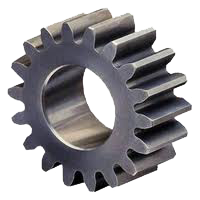Spur Gears

The spur gear is is simplest type of gear manufactured and is generally used for transmission of rotary motion between parallel shafts. The spur gear is the first choice option for gears except when high speeds, loads, and ratios direct towards other options. Other gear types may also be preferred to provide more silent low-vibration operation. A single spur gear is generally selected to have a ratio range of between 1:1 and 1:6 with a pitch line velocity up to 25 m/s. The spur gear has an operating efficiency of 98-99%. The pinion is made from a harder material than the wheel. A gear pair should be selected to have the highest number of teeth consistent with a suitable safety margin in strength and wear.The minimum number of teeth on a gear with a normal pressure angle of 20 desgrees is 18.
Spur gears are the most common type used. Tooth contact is primarily rolling, with sliding occurring during engagement and disengagement. Some noise is normal, but it may become objectionable at high speeds.
Spur gears are the most commonly used gears in the market. Spur Gears are found generally in the form of a cylinder or disk. These gears are applied for varying the force and speed of a rotating axle. These gears have a straight teeth. They are usually mounted on parallel shafts. These days mostly the tooth form is based on the involute curve. For creating large gear reductions, many spur gears are used together.
Types of Spur Gears:
Internal Spur Gears
This is actually a type of Spur Gear. Internal Spur Gears are not much different from a regular spur gear. These gear by appearance shows pitch surface that is cylindrical. Here the tooth is parallel to the axis. In case of Internal Spur Gears, the gears are positioned to make internal contact. It is also referred to popularly as Ring gears. The output rotation produced by the Ring gears is direction wise same as that of input rotation.
External Spur Gears
External Spur Gears are the most popular and common type of spur gear. They has their teeth cut on the outside surface of mating cylindrical wheels. While the larger wheel is referred to as the gear and the smaller wheel is known as the pinion. Single reduction stage is the most basic type of arrangement of single pair of spur gears. Here the output rotation is in opposite direction to that of the input. In other arrangements of multiple stages higher net reduction can be achieved where the driven gear is connected rigidly to a third gear. This third gear in turn drives a mating fourth gear. This serves as the ideal output for the second stage. In this way, many output speeds on different shafts are produced starting from a just single input rotation. The image given below shows the inside of External Spur Gears.
Spur Gears are the most popular form and the most efficient type of gearing for the cost when transmitting power and uniform rotary motion from one parallel shaft to another. Within the limitations of center distance, spur gears provide a positive, constant speed drive, the speed of which may be increased or decreased by increasing or decreasing the number of teeth in the driving gear.
Spur Gears may be operated in a “gear-train” of two or more gears but they must all be of the same diametral pitch and pressure angle. Gears with 14-1/2° pressure angle will not operate with those cut to 20° pressure angle.
|

